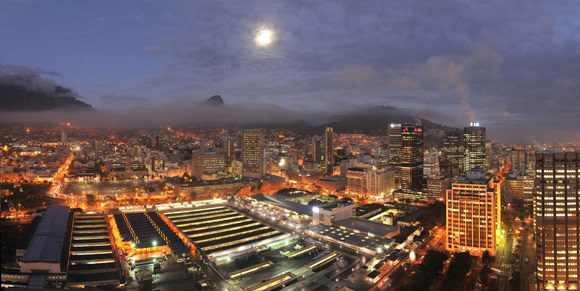Cities: The new frontier of sustainable development
01 December 2014
When we think of iconic cities around the world, we often imagine their skylines – think New York, Paris, Shanghai, Sydney. But is this kind of urbanisation inevitable? asks Aromar Revi, director of the Bangalore-based Indian Institute for Human Settlements. Moreover, is it desirable?
"Is this kind of urbanisation inevitable?" asked Aromar Revi, pointing to a photograph of the New York skyline, with the 'new' World Trade Centre dating the picture decisively. "Is this kind of urbanisation inevitable across the world?"
A city like this was great for its time, but is it what we want for the future?
This is the question posed by Revi, director of the Bangalore-based Indian Institute for Human Settlements, during his delivery of the first Africa-based talk to form part of the Kapuscinski Development Lecture series. The talk was hosted by UCT's African Centre for Cities, and the series commemorates the work of Polish journalist and writer Ryszard Kapuscinski, who was renowned for his reportage of developing countries.
In the century between the 1950s and 2050, a shift is happening across the world, from civilisation being predominantly agrarian and rural, to one that's predominantly urban. Urbanisation is a 'giga-trend', Revi says, and something which now puts cities at the epicentre of the challenges linked to climate change, population growth and environmental resource depletion. But because cities also concentrate so many development issues, they also present a unique opportunity for academics, researchers and policy-makers to change the everyday lives of ordinary people.
"And the core thing we're talking about here, is: what is the role of cities and towns in this?"
In 1900, the global population was just 1.5 billion, 13% of whom lived in cities. The gross world product was $2 trillion, and the urban share of that was already a significant 30%. By 1950, with the post-World War II population at 2.5 billion, the gross world production was up to $7 trillion, and cities accounted for 45% of that economic output.
Fast forward to today: a population of 7 billion people, 70% of which are urban (although not yet in Africa).
"This is what's significant, though. In just 60 years, gross world production has jumped from $7 trillion to $70 trillion."
By 2025, the population will be up to 8 billion people, the gross world production up to $85 trillion, and 75% of that will be generated by cities. This is why governments need to take cities seriously: because the urban economy is responsible for most of the world's consumption, output and employment.
"Most jobs are driven by cities – that's why cities are critical."
Because of this concentration of pressures and challenges – such as issues linked to the economy, demographics, health, education, energy and the environment – Revi maintains that cities present a unique opportunity to tackle development meaningfully. "And this is the touchstone of everything we do; it's about changing the everyday lives of ordinary people."
A tale of two cities
The remains of the ancient Indian citadel Dholavira tell the story of an urban hub that was able to adapt to environmental change.
"There was a shift in the climate, and the system crashed," explained Revi, "but the city adapted over a period of 1 000 years. They built massive water storage systems, brick by brick, carved from rock."
But Old Goa, in the north of India, collapsed because its inhabitants didn't understand the environment. They sunk wells into the ground for drinking water, but also had cesspools, so the people of the city were plagued by cholera and dysentery.
"This city died in less than 200 years. In the history of civilisation, the collapse of cities has led to the collapse of cultures. But where we are going to isn't inevitable; it's based on the choices we make."
Setting a sustainable development goal M.b.
"Changing the goals of the system – and the system is us – is a leverage point," he said. "For instance, 200 years ago, some parts of the world decided that slavery was unacceptable, and the system goals were changed. Similarly, the universal declaration of human rights re-oriented the world. We are at an interesting junction in sustainability right now, and we need to re-organise the core goals of the world, countries and institutions."
There is a small window of opportunity in which to steer urban transformation appropriately, but this needs city-scale development goals that reflect the kinds of global goals drawn up by the United Nations in the Millennium Development Goals (MDGs) and the Sustainable Development Goals (SDGs).
A recent meeting of mayors from 200 of the world's major cities, along with representatives from regional governments, academics, people's movements and international organisations, saw them discuss the idea of drawing up an urban sustainable-development goal. In fact, without such a goal, Rio de Janeiro mayor Eduardo Paes argued, the SDGs will remain incomplete.
Revi presented the first target of such an urban SDG, which should aim to "end extreme urban poverty, expand employment and productivity, and raise living standards, especially in slums".
The second two targets, which Revi wasn't able to present in the talk due to time constraints, are to "ensure universal access to a well-designed, secure, and affordable built environment and basic urban services, including housing; water, sanitation and waste management; low-carbon energy and transport; and mobile and broadband communication" and to "ensure safe air and water quality for all, and integrate reductions in greenhouse gas emissions, efficient land and resource use, and climate and disaster resilience into investments and standards".
However, a goal like this will need new governance architecture that balances inter-generational and intra-generational equity, and considers the interests of nation-states, local and regional governments, private-sector firms, and the rights of communities and citizens.
"Cities are the most complex environments we've ever created. We haven't always run them properly. But they are rich, and well-resourced in terms of human resources and capacity. And they are the most significant places where change and development can happen," he said.
The next crucial step, Revi concluded, is implementation.
Aromar Revi was speaking at the Kapuscinski Development Lecture series, delivered for the first time in Africa at UCT on 5 November 2014, and held during the Africa Centre for Cities' City Desired exhibition.
Story by Leonie Joubert. Photo by Bruce Sutherland.
 This work is licensed under a Creative Commons Attribution-NoDerivatives 4.0 International License.
This work is licensed under a Creative Commons Attribution-NoDerivatives 4.0 International License.
Please view the republishing articles page for more information.
News
Feature
Front page
Focus
Photo Essay
Faculty Focus - Science
Previous Editions










